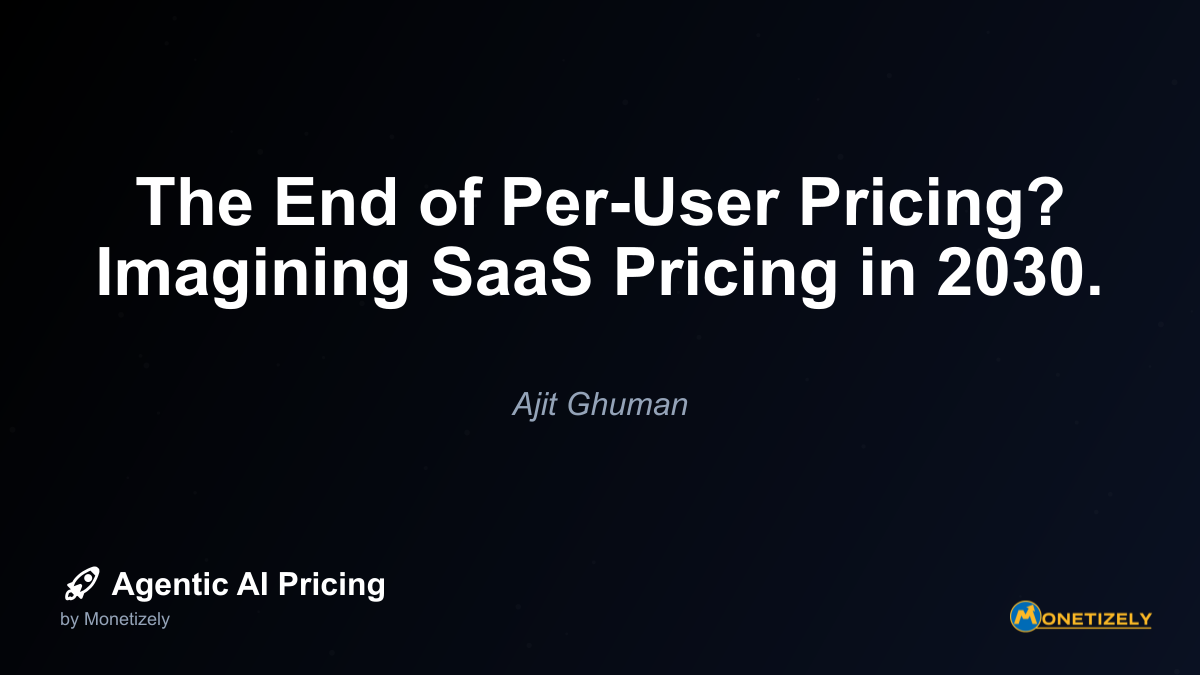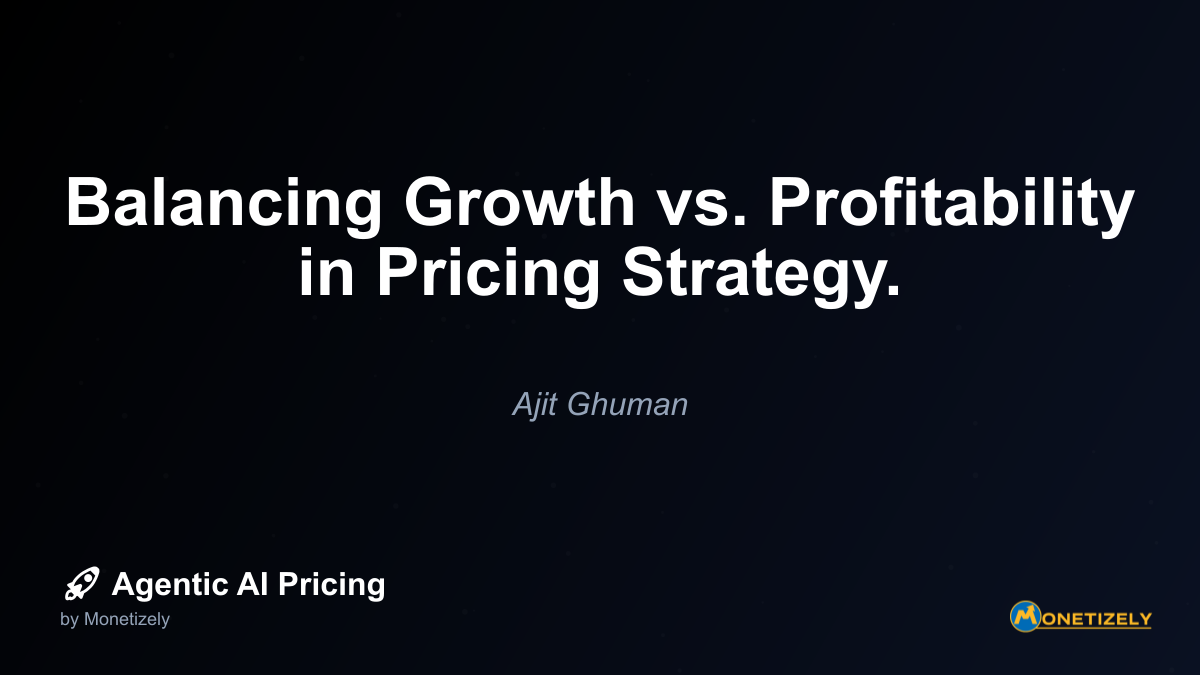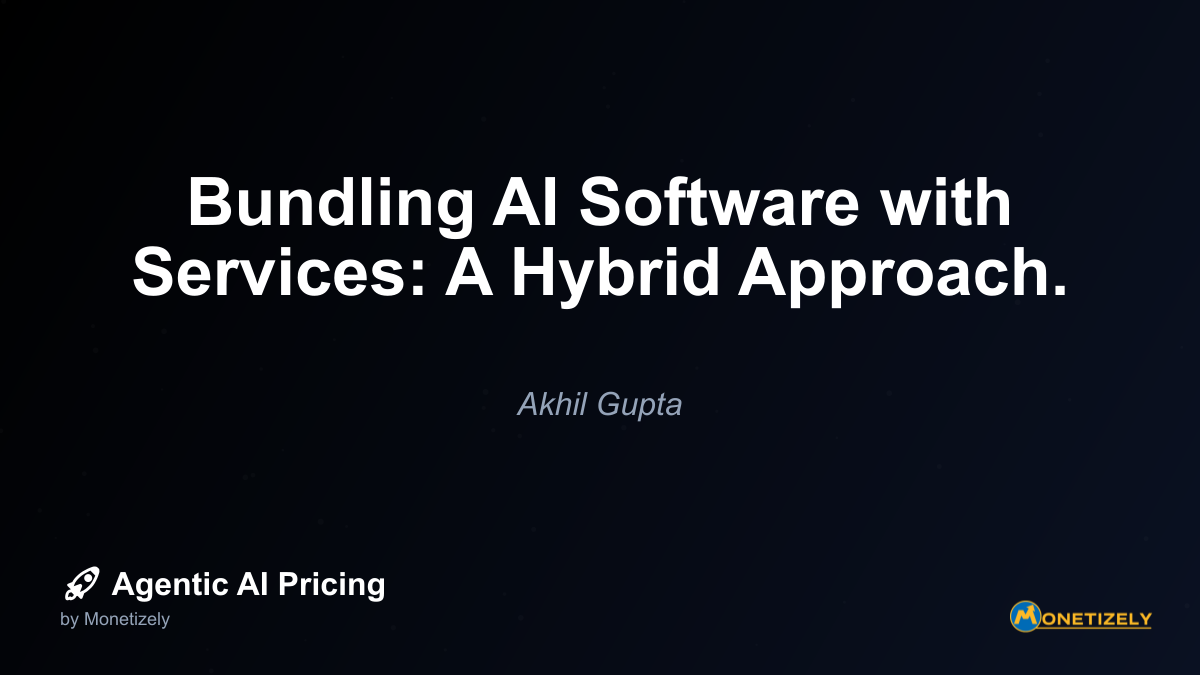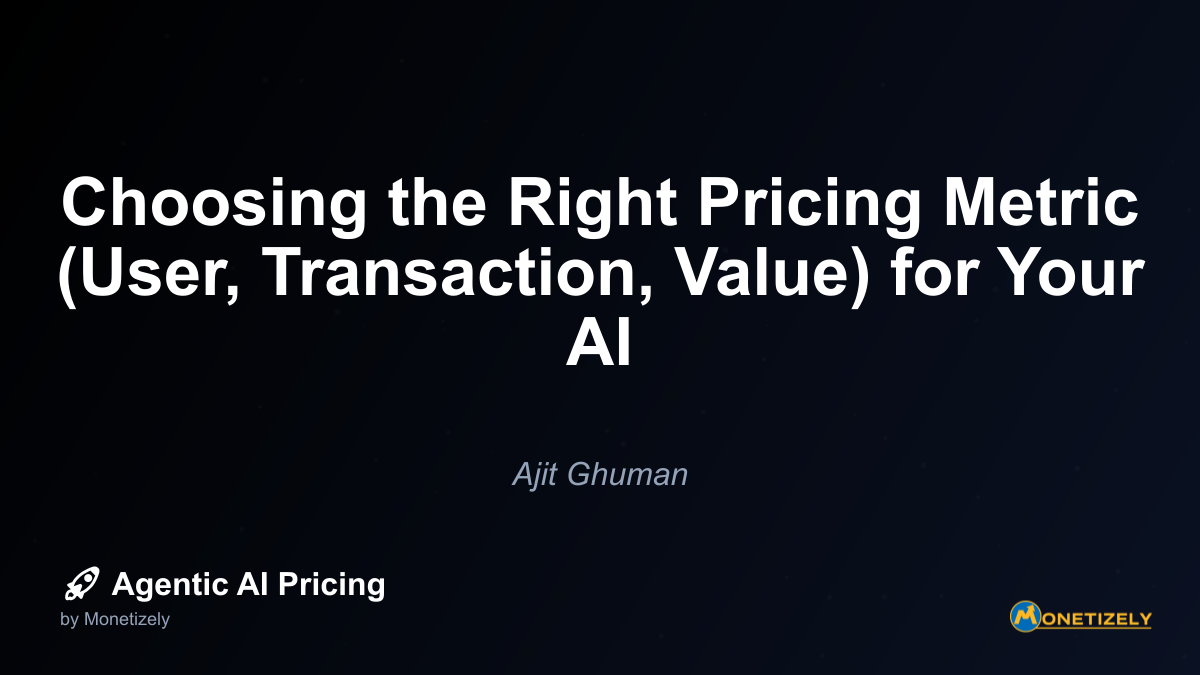· Ajit Ghuman · Strategy & Planning · 9 min read
The End of Per-User Pricing? Imagining SaaS Pricing in 2030.
AI and SaaS Pricing Masterclass
Learn the art of strategic pricing directly from industry experts. Our comprehensive course provides frameworks and methodologies for optimizing your pricing strategy in the evolving AI landscape. Earn a professional certification that can be imported directly to your LinkedIn profile.

As AI agents become more capable of performing tasks traditionally handled by human workers, the fundamental premise of per-user pricing begins to crumble. When a single AI agent can do the work of multiple humans, the correlation between headcount and value breaks down.
Consider this scenario: By 2030, a marketing team might employ just three human specialists who leverage five AI agents to perform work previously requiring 15 staff members. Under a per-seat model, the software vendor would lose 80% of their revenue despite delivering the same or greater value.
This dynamic creates an inherent conflict of interest: software vendors would be financially incentivized to limit automation and AI adoption—directly opposing their customers’ efficiency goals.
The Shift to API-First and Headless Architecture
Modern software architecture increasingly embraces API-first design and headless components that can be assembled into custom workflows. These technical approaches enable software consumption without direct human interaction, further eroding the logic of per-user pricing.
In these scenarios, the value derives from the volume of operations performed or data processed rather than the number of humans accessing the system. This architectural shift naturally favors usage-based pricing models that better reflect how the software creates value.
Customer Demand for Value-Based Pricing
Business customers are becoming increasingly sophisticated about software ROI. They’re pushing back against paying for “shelfware” (unused licenses) and demanding pricing models that more directly tie costs to realized value.
This pressure will likely intensify as economic conditions fluctuate and companies scrutinize their software spending more closely. CFOs and procurement teams are already asking tougher questions about the correlation between seat licenses and business outcomes.
The Competitive Advantage of Flexible Pricing
Early adopters of more sophisticated pricing models are gaining competitive advantages. By 2030, companies still clinging to rigid per-seat pricing may find themselves at a significant disadvantage when competing against more flexible alternatives.
The Emerging Pricing Landscape of 2030
What might replace the per-user paradigm? Several models are likely to gain prominence:
Usage-Based and Consumption Pricing
By 2030, we can expect usage-based pricing to become the dominant model for many software categories. This approach directly ties costs to actual consumption of resources or service utilization.
Key metrics might include:
- Number of operations performed
- Data volume processed
- Compute resources utilized
- API calls made
- Transactions completed
This model offers several advantages:
- Natural scaling with actual usage rather than theoretical access
- Lower barriers to entry for new customers
- Better alignment with value delivery
- Ability to accommodate both human and AI users
Outcome-Based and Value Pricing
The most sophisticated pricing approaches by 2030 will likely tie costs directly to business outcomes achieved. While technically challenging to implement, these models create the strongest alignment between vendor and customer success.
Examples might include:
- Marketing software priced per qualified lead generated
- Sales tools charging a percentage of deals closed
- Customer service platforms billing based on resolution rates
- Analytics tools priced on cost savings identified
These models require robust tracking mechanisms and agreement on attribution, but advances in analytics and AI will make them increasingly feasible.
Hybrid Models with Foundation + Usage Components
Many SaaS companies will likely adopt hybrid approaches that combine a modest base subscription with usage-based components. This provides vendors with some revenue stability while still aligning with customer value.
A typical structure might include:
- Base platform fee (smaller than today’s full license costs)
- Usage-based components for specific high-value features
- Outcome-based elements for core value drivers
Industry-Specific Pricing Innovations
Different software categories will evolve distinct pricing approaches based on their unique value dynamics:
AI-Enhanced Creative Tools
Tools like Adobe Creative Cloud or Canva might shift from per-user to output-based pricing (per image rendered, video produced, or design published), potentially with quality tiers based on resolution or complexity.
Data Analytics Platforms
Analytics tools might price based on the volume of data processed, insights generated, or even the financial impact of decisions made using the platform.
Communication and Collaboration Platforms
These might adopt hybrid models with modest per-user components combined with usage metrics like meeting minutes, messages sent, or documents shared.
Enterprise Resource Planning (ERP)
ERP systems might price based on transaction volume, revenue processed, or even a percentage of cost savings achieved through operational efficiency.
The Practical Transition: How We’ll Get There
The shift away from per-user pricing won’t happen overnight. Several transitional steps will likely characterize the journey to 2030:
Phase 1: Experimentation (2023-2025)
We’re currently in this phase, where innovative SaaS companies are testing alternative pricing models alongside traditional approaches. Most are introducing usage components as add-ons to existing per-seat structures.
Key developments include:
- Increased transparency about usage metrics
- Introduction of hybrid models
- Testing of different value metrics
- Early adopters fully embracing usage-based approaches
Phase 2: Mainstream Adoption (2026-2028)
As successful models emerge from the experimentation phase, mainstream SaaS companies will begin more aggressive transitions away from pure per-seat pricing:
- Major platforms will introduce usage-based alternatives
- New startups will launch primarily with consumption models
- Customers will increasingly expect and demand value-aligned pricing
- Analytics tools for measuring software value will mature
Phase 3: New Normal (2029-2030)
By this phase, per-seat pricing will likely become a minority approach, primarily persisting in legacy systems and specific niches where user count genuinely correlates with value:
- Usage and outcome-based models become standard
- Sophisticated value-tracking mechanisms are widespread
- AI agents are fully integrated into pricing considerations
- New business models emerge around software value optimization
Implications for Software Companies
For SaaS businesses, this transition represents both opportunity and challenge:
Revenue Model Transformation
The shift away from per-user pricing requires fundamental changes to revenue models. Companies will need to:
- Identify the true value drivers of their software
- Develop robust usage monitoring capabilities
- Build more sophisticated billing systems
- Rethink sales compensation structures
- Adjust investor communications around growth metrics
Product Development Focus
Product teams will need to orient development around measurable value delivery rather than feature expansion:
- Instrumenting products to track usage and outcomes
- Designing for efficiency (when usage drives costs)
- Creating dashboards that demonstrate ROI
- Building value-verification mechanisms
Customer Success Becomes Critical
When pricing aligns with outcomes, customer success becomes directly tied to revenue:
- Increased investment in onboarding and adoption
- More proactive usage monitoring and intervention
- Development of value-realization methodologies
- Closer integration between success teams and billing
Implications for Software Customers
For businesses purchasing software, the evolution presents significant opportunities:
Better ROI Alignment
Customers will benefit from pricing that more accurately reflects the value they receive:
- Paying only for actual usage, not potential access
- Scaling costs with realized benefits
- Avoiding wasted licenses for occasional users
- Easier justification of software investments to finance teams
More Flexible Scaling
Usage-based models allow for more natural scaling with business needs:
- Easier departmental adoption without large upfront commitments
- Ability to expand or contract usage as needed
- Accommodation of seasonal or cyclical business patterns
- Support for both human and AI-driven workflows
Greater Vendor Accountability
When vendors are paid based on usage or outcomes, they become more invested in customer success:
- Increased vendor attention to adoption and value realization
- More transparent ROI calculations
- Stronger incentives for vendors to improve product efficiency
- Better alignment between customer and vendor goals
Challenges and Considerations
While the shift away from per-user pricing offers many benefits, it also presents significant challenges:
Predictability and Budgeting
Usage-based models can make costs less predictable, creating budgeting challenges:
- Potential for unexpected cost spikes with heavy usage
- More complex forecasting requirements
- Need for usage monitoring and governance
- Potential for “bill shock” without proper controls
Implementation Complexity
For vendors, implementing sophisticated pricing models requires substantial investment:
- Building robust usage tracking infrastructure
- Developing fair and transparent billing mechanisms
- Creating clear customer communication about costs
- Managing transition periods with existing customers
Resistance to Change
Both vendors and customers may resist abandoning familiar models:
- Sales teams comfortable with per-seat selling
- Procurement teams with established license evaluation processes
- Finance departments with existing budgeting approaches
- Investors focused on traditional SaaS metrics
Who Will Lead and Who Will Follow?
Not all software categories will transition at the same pace:
Early Adopters
These categories are already shifting and will likely complete their transition by 2030:
- Developer tools and APIs
- Data processing platforms
- AI and machine learning services
- Marketing automation tools
- Communication platforms
Followers
These categories will move more gradually but still significantly transform by 2030:
- CRM and sales tools
- Project management software
- Design and creative tools
- HR and talent management platforms
- Financial and accounting software
Late Adopters
Some categories may retain significant per-user components even by 2030:
- Legacy enterprise systems
- Specialized professional tools with regulated users
- Software with high compliance or security requirements
- Tools where individual usage patterns are highly consistent
Preparing for the 2030 Pricing Landscape
How can software companies and customers prepare for this evolving future?
For Software Vendors
Start experimenting now: Introduce optional usage-based components alongside existing models to gather data and customer feedback.
Invest in usage analytics: Build robust systems for tracking how customers use your product and what outcomes they achieve.
Identify your true value metrics: Determine which aspects of your software create the most customer value, and how they might be measured.
Prepare your organization: Begin educating sales, success, and finance teams about the future of pricing and the rationale for change.
Design for the AI-augmented workforce: Ensure your pricing strategy accommodates both human users and AI agents working alongside them.
For Software Customers
Audit your current utilization: Understand how effectively you’re using your current per-seat licenses and identify areas of waste.
Request usage data: Ask vendors for detailed usage metrics to better understand your consumption patterns.
Pilot alternative models: When vendors offer usage-based options, consider piloting them in specific departments to evaluate the impact.
Develop value measurement frameworks: Create methodologies for assessing software ROI beyond license costs.
Build flexible budgeting approaches: Prepare finance teams for more variable software costs tied to actual usage and outcomes.
Conclusion: The End of an Era, The Beginning of Value
The per-user pricing model has served the software industry well during its initial growth phase. It provided simplicity and predictability when both were needed. But as software becomes more deeply integrated into business processes and increasingly augmented by AI capabilities, the fundamental premises of per-seat pricing are eroding.
By 2030, we’re likely to see a fundamentally transformed landscape where most software is priced based on the actual value it delivers—whether measured through usage, outcomes, or hybrid approaches. This evolution represents not just a pricing change but a more mature relationship between software providers and their customers.
The winners in this new era will be companies that embrace the change proactively, developing pricing models that truly align with how their products create value in an increasingly automated world. For customers, the shift promises greater efficiency, flexibility, and return on their software investments.
The end of per-user pricing isn’t something to fear—it’s an opportunity to create stronger, more value-aligned relationships between those who create software and those who rely on it to power their businesses.
Co-Founder & CEO
Ajit is the author of Price To Scale, a top book on SaaS Pricing and is the Founder of Monetizely. Ajit has led and worked in pricing and product marketing at firms like Twilio, Narvar and Medallia. His work has been featured in Forbes and VentureBeat. Ajit regularly consults with software companies from Seed stage to post-IPO on pricing strategy. Ajit is also a highly-rated co-instructor for 'The Art of SaaS Pricing and Monetization' on Maven.
Pricing Strategy Audit
Let our experts analyze your current pricing strategy and identify opportunities for improvement. Our data-driven assessment will help you unlock untapped revenue potential and optimize your AI pricing approach.




